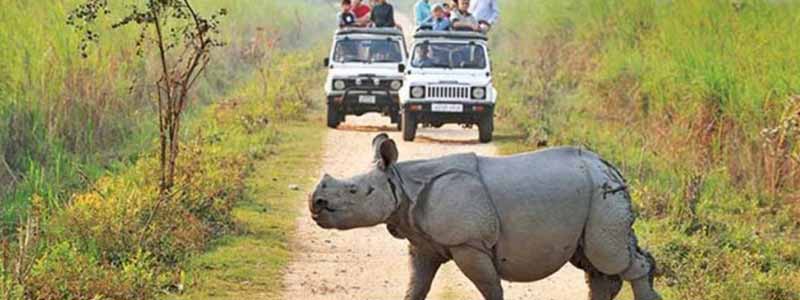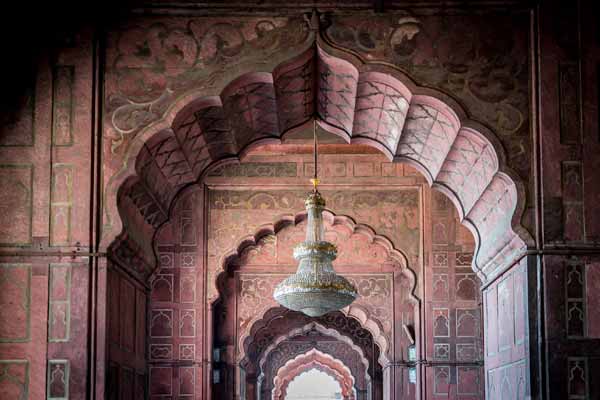Top 5 UNESCO World Heritage Sites in India takes pride in flaunting its unsurpassed heritage; eras over eras have influenced, moulded and face lifted the rich heritage of which we all are part of. Distinctive edifices, perennial culture and the determination to keep this incredibility have preserved for us an era no short of marvels. With a startling number of places and monuments enlisted in the list of UNESCO World Heritage Sites, India has made an indelible mark in world history.
The natural splendor maintaining its domain over many parts of the country boasts of magnificent wildlife heritage. From the float of crocodiles at Sunderban National Park to the home of snow leopards at Nanda Devi Biosphere Reserve, from the majestic Manas Wildlife Sanctuary to the Keoladeo National Park and Kaziranga National Park, India humbly possess the most diverse heritage in the world. The lush flora and the tailored landscape around it has been the prime attraction in the country, right from the red rhododendrons to the Neelakurinji, which bloom once every 12 years and from the moonscape Ladakh to the river island Majuli, the kaleidoscope of wildlife and natural heritage never ceases to amaze us in India.

Kaziranga National Park
Name of NWH Site: Kaziranga National Park
State: Assam
Year of Notification: 1985
Area (In Km2): 429.96
Kaziranga National Park is situated in the Golaghat and Nagaon districts of Assam. The national park is famous for the rhino populations, and according to the latest census conducted by the Forest Department of Assam, there are more than 2401 rhinos living in this forest area. If you recall the historical facts then you will get to know about the royal significance of this national park in India.
Once Mary Curzon, the wife of Lord Curzon visited in this place with her husband and she suddenly identified a rhino in this forest. She requested her husband to protect this place and to stop animal hunting in this national park. Afterward, Lord Curzon protected this place and declared this forest area as a reserved forest in 1916. The Kaziranga National Forest was enlisted as a Top 5 UNESCO World Heritage Sites in India in the year 1985.
Along with some rhinos, you can also find some rare and migratory birds in Kaziranga National Park, like, Asian openbill stork, black bellied tern, delmatian pelican, greater spotted, eastern imperial and lots more. According to etymology, the Kaziranga name was derived from an incident, which happened in nearby villages.
Kazi was a boy and Ranga was a girl who lived in the nearby villages and they fell in love, but the society did not accept their gesture. Afterward, they disappeared in the forest area and never came out of this forest. So the forest was named as Kaziranga as a symbol of their love. So there are multiple myths surrounding this forest.
Humayun’s Tomb, Delhi
Name of NWH Site: Humayun’s Tomb
State: Delhi
Year of Notification: 1993
Humayun’s Tomb was dedicated to Humayun’s first wife and chief consort named Bega Begum. During 1569 to 1570 the famous Persian architect Mirak Mirza Ghiyas structured this tomb.
The tomb is located near Nizamuddin East and this was the first garden tomb in India. UNESCO added this site as World Heritage Site in the year 1993, and afterward, some extensive restoration works have been done on this tomb.
Here you can find the main Humayun’s Tomb at the center of the garden area. Inside this tomb, you can find several houses. Along with that, the graves of Bega Begum, Hamida Begum and Humayun’s grandson Dara Shikoh are also situated inside this tomb.
The tomb is designed with Mughal architecture and the surrounded garden areas follow the Persian garden styles.
You can find two large double story gateways to the west and southern side of the tomb, which are designed with several rooms and courtyards. The tomb is designed with rubble masonry and red sand stones, and you can find some great marble works on the floors.
The tomb is situated in Char Bagh Garden area and this Persian style garden has some long paved pathways and two central major water channels. This garden was known as Garden of Paradise, and the entire tomb area along with its garden are protected with high rubble walls Top 5 UNESCO World Heritage Sites in India.
Group of Monuments in Hampi
Name of NWH Site: Group of Monuments in Hampi
State: Karnataka
Year of Notification: 1986
According to Emperor Asoka’s Rock Edicts, the Hampi district was a part of the Maurya Empire and large numbers of Brahmi inscriptions along with some terracotta works have been founded in this place during the excavation conducted in 2nd century CE.
Hampi is was to the list of Top 5 UNESCO World Heritage Sites in India in India in 1986. This place is situated in Karnataka State, India.
You can find some ruins of the city of Vijayanagara, which was the former capital of the Vijayanagara Empire. The monuments of Vijayanagara are divided into different parts such as rebellions, civil and military buildings. You can see the oldest Jain temple on Hemakuta hill where two Devi shrines are situated with other oldest structures.
Apart from that, in Hampi, you can also find some remarkable historical places like Achyutaraya Temple, BadaviLinga, Chandramauleshwara Temple, Malyavanta Raghunathaswamy Temple, Hazara Rama Temple, Jain Temple and Krishna Temple and Vittala Temple.
Inside the Krishna Temple, you can also find the famous sacred tank named Pushkaranion the eastern side.
Ajanta Caves, Near Aurangabad
Name of NWH Site: Ajanta Caves, Near Aurangabad
State: Maharashtra
Year of Notification: 1983
Ajanta Caves in Aurangabad, Maharashtra were added as a UNESCO World Heritage Site in the year of 1983. You can find some ancient paintings and sculptures on these caves, which describe the oldest Indian art forms. Expressions of these paintings through different gestures, poses and forms are really expressive.
According to notable historians, these paintings and arts are the masterpieces of Buddhism, and through these art forms, people get to know about the oldest Indian art Top 5 UNESCO World Heritage Sites in India.
According to the historical facts, the first phases of the Ajanta Caves were built during 2nd century BC and the second phases of these caves were built during 400-650 CE.
You can find some ancient paintings on the caves, which describe the rebirth of Buddha, and you can also find some prayer and worship halls and monasteries inside the caves which show the different types of traditions of Buddhism.
According to old manuscripts, monks, pilgrims and merchants used to stay inside these caves during the monsoons. Caves no 1, 2, 16 and 17 are the most ancient Indian wall paintings. you can also find some mural wall paintings, which were painted with vivid natural colors.
Taj Mahal, Agra
Name of NWH Site: Taj Mahal, Agra
State: Uttar Pradesh
Year of Notification: 1983
The Taj Mahal – one of the Seven Wonders of the World is situated on the south bank of Yamuna River in Agra. The most beautiful building in the world – Taj Mahal is designed with marble stones from Makrana of Rajasthan. Taj Mahal was structured by Mughal Emperor Shah Jahan for his wife Mumtaz Mahal.
This is a house of tomb which means Crown of Palace. You can find three sided lush garden areas, guest rooms and a mosque inside the Taj Mahal premises. The construction of the Mahal was completed in 1643, but the external parts and other phases of this project contented another ten years and the full premises and construction was done by 1653.
Nobel laureate Rabindranath Tagore described the Taj Mahal as “the tear drop on the cheek of time”. UNESCOadded this site as World Heritage Site in 1983 and they have added this site as “the jewel of Muslim Art in India and one of the universally admired masterpieces of the world’s heritage”.
The Taj Mahal followed the earlier Mughal architecture and Persian art forms. The tomb of Taj Mahal is the main highlighted area, and the tomb was designed with marble and situated on the square plinth Top 5 UNESCO World Heritage Sites in India.
You can find four minarets inside the tomb, and the actual graves of Mumtaz and Shah Jahan were placed at the lower level of this tomb area. But for the audiences, false sarcophagi were made in the main chamber of the Taj Mahal. You can find the superior decoration and art forms at the exterior and interior level of this Mahal, and the exterior decoration was created by paint, stucco and stone carving Top 5 UNESCO World Heritage Sites in India.
